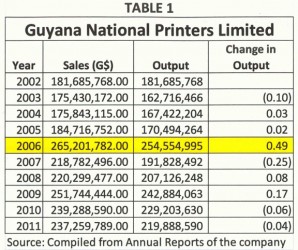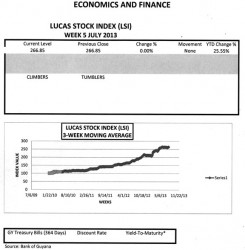Mood of the company
The Guyana National Printers Limited (GNPL) will be celebrating its 75th birthday next year. At its current age, GNPL, one of 13 that qualify as a public enterprise, also has seen its share of good and bad times, and survived many unwanted incursions and relationships in its lifetime. No one knows therefore what mood the company will be in at the time of its Diamond Jubilee, given that it has been living a life in limbo for the last 10 years, devoid of any real capacity to compete and grow in the domestic and foreign markets. The plight of the company stems from a desire to return it to private hands and in pursuit of that objective, the imposition of hard budget constraints by government to limit the financial exposure of taxpayers on whose behalf it acts in owning and controlling the enterprise. The hold-up on disposal is unclear and so is its impact on the company. This article analyses the performance of the company under these trying circumstances to gain an understanding of how it is managing to survive. To appreciate the conclusion reached about the company’s future, it is useful to know something of its past. Of necessity, therefore, this article will be of two parts.
A time series analysis of the company’s performance over a 10-year span reveals the ability of management and a dwindling staff to expand production in an environment that challenges its capacity to boost sales revenues. The analysis also reveals that the ‘termination by starvation’ policy employed by the Government of Guyana might be finally taking its toll on the enterprise which, despite valiant efforts by its management and staff, seems to be slowly losing its ability to maintain production as the table below indicates. Without life support, the company could be in danger of disappearing. The output for the years in Table 1 is based on a starting output at 2002 which was adjusted annually for changes in price. The year 2006 was special for the company since it received a large demand from the Guyana Elections Commission. Removing the effects of the exceptional demand for that year, the company might have had a sustained growth for six years from 2004 to 2009.

Born in 1939 as B.G. Lithographic to a sole proprietor named Leon Schuler, the company began its long journey as a printing establishment in service of businesses and households in Guyana and the West Indies. The need for new technology and a desire to modernize its operations to meet a growing market demand saw the young company attracting the attention of a high-profile suitor. As a result, in 1942, just three years after emerging on the scene, B.G. Lithographic fell into the arms of Messrs Booker McConnell and Company, Limited, a much larger and financially endowed entity. Bookers, as the larger company was often called in Guyana, maintained control of the printing facility until 1976 when the operations fell prey to the wave of nationalization that was sweeping the country at the time.


The Lucas Stock Index (LSI) remained unchanged in trading during the final week of July 2013. Trading was limited to two companies in the LSI with a total of 131,100 shares in the index changing hands this week. Trades were made by Banks DIH (DIH) which sold 131,000 shares and by Demerara Tobacco Company (DTC) which sold 100 shares.
Target of retribution
Based on the oral history of former employees, the company never really struggled either in the free market environment or under the phase of widespread national control. A June 13, 1960 Glasgow Herald article reported that in the financial report for the year 1959, Bookers Brothers, McConnell and Company, Limited made the following disclosure, “In British Guiana, printing … did well.” The company had contributed to a 15 per cent increase in profits over the previous year for the light industries of the Bookers McConnell group of companies. At that time, ‘Litho-graphic’ was a premier printing facility that had some of the best skills for lithography printing. It was therefore capable of competing successfully with or without favoured market treatment. But the special place that it enjoyed in the Guyana economy during the eighties and early nineties probably made it the envy of many and a potential target of retribution. Pushing on in age, the company is now a shadow of itself with few friends in positions of influence. Age has taken its toll on the company which, like a tired and incapacitated socialite, has been left to survive on its past glory.
Lamentations
The environment in which the mature company is operating might be too fast and modern for it. Its annual reports from 2002 to 2011 are replete with lamentations of production problems, disclosures of an inability to respond to market demand for certain products and being left to watch helplessly as competitors surpass it with supreme technology. Its pleas for better equipment have gone unanswered for these many years, ostensibly because the company is targeted for disposal. A visit by the President last December to the facilities of the beleaguered company appears not to have clarified its status. Without modernization, the company is heading for extinction and its upcoming Diamond Jubilee is hardly likely to sparkle. Yet, in this period of austerity, GNPL has exhibited some good management.
(To be continued)





